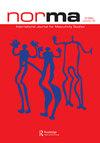性腺机能减退。诊断,阳刚之气和资本在睾酮缺乏的叙述
IF 2.1
Q2 SOCIOLOGY
引用次数: 1
摘要
几个世纪以来,男性性腺功能减退一直被定义为一种临床综合征,由无法产生生理浓度的睾丸激素和/或正常数量的精子引起。2020年,瑞典启动了一项信息宣传活动,旨在提高对性腺功能减退和睾丸激素(缺乏)的认识,目标人群包括男性和医疗保健提供者。在这项研究中,我们仔细研究了瑞典媒体在2018-2021年期间对性腺功能减退症的讨论。通过对生物医学化的女性主义思考,我们分析了在当代新自由主义和生物资本时代,关于男性、年龄和健康的现象和问题的媒体材料。对一些人来说,性腺功能减退症是一种严重的疾病,但我们也可以看到,诊断是对一系列症状的反应,扩大了诊断实践的领域,并与年龄、时间和缺乏或消退的男性气概的规范观念联系在一起。关于性腺功能减退的媒体叙述不仅反映了关于男性气质的文化规范和诊断的可塑性,而且创造了欲望、需求和市场。本文章由计算机程序翻译,如有差异,请以英文原文为准。
Hypogonadism. Diagnosis, masculinity, and capital in narratives about testosterone deficiency
ABSTRACT For centuries, male hypogonadism has been defined as a clinical syndrome caused by the inability to produce physiological concentrations of testosterone and/or normal amount of sperm. In 2020, an information campaign started in Sweden with the ambition of increasing knowledge about hypogonadism and (lack of) testosterone, targeting both men and healthcare providers. In this study, we take a closer look at media discussions in Sweden on hypogonadism over the period 2018–2021. Through feminist thinking on biomedicalisation, we analyse the media material about the phenomena and issues being raised regarding masculinity, age and health in contemporary neoliberal and biocapital times. For some people, hypogonadism is a severe condition, but we can also see that the diagnosis becomes a response to a wide range of symptoms, expanding the realm for diagnostic practices and tying into normative ideas about age, time and lacking or fading masculinity. The media narratives about hypogonadism not only reflect cultural norms regarding masculinity and the plasticity of diagnoses but also create desires, needs and markets.
求助全文
通过发布文献求助,成功后即可免费获取论文全文。
去求助
来源期刊

NORMA
Social Sciences-Gender Studies
CiteScore
3.00
自引率
14.30%
发文量
23
期刊介绍:
NORMA is an international journal for high quality research concerning masculinity in its many forms. This is an interdisciplinary journal concerning questions about the body, about social and textual practices, and about men and masculinities in social structures. We aim to advance theory and methods in this field. We hope to present new themes for critical studies of men and masculinities, and develop new approaches to ''intersections'' with race, sexuality, class and coloniality. We are eager to have conversations about the role of men and boys, and the place of masculinities, in achieving gender equality and social equality. The journal was begun in the Nordic region; we now strongly invite scholarly work from all parts of the world, as well as research about transnational relations and spaces. All submitted manuscripts are subject to initial appraisal by the Editors, and, if found suitable for further consideration, to peer review by independent, anonymous expert referees. All peer review is double blind and submission is online via Editorial Manager.
 求助内容:
求助内容: 应助结果提醒方式:
应助结果提醒方式:


